There are more than four hundred native bee species in Minnesota, which includes twenty-three native bumble bee species. Bees are essential pollinators, pollinating wildflowers and crops.
While we cannot list all the bee species in Minnesota, we have compiled a list from the more common species to the least common species. Continue reading to find out more.
Table of Contents
1. Common Eastern Bumble Bee
The Common Eastern Bumble Bee (Bombus impatiens) is one of the most commonly encountered bumble bees in Minnesota. These bees live in suburbs, urban areas, and in the country.
They are adaptable, which makes them excellent pollinators, used extensively in the greenhouse industry. These bees have short hair and long, rectangular-shaped bodies. They can grow to 23mm in queens, 16mm in workers, and 18mm in males.

Queens and workers are black with a yellow first abdominal segment and thorax, while males have a yellow head and face. This species also does well in wooded habitats, nesting underground in open woods and fields.
2. Brown-belted Bumble Bee

Brown-belted Bumble Bees (Bombus griseocollis) are native to the United States with queens growing to 23mm in body length with a black head and face and scattered yellow hairs. They have a yellow thorax with black and yellow banding on the abdomen and a black posterior.
Workers are not as large as the queen, growing to around 1cm in body length, they are similar in color but have a brown and yellow banded abdomen. The males can grow to 1.9cm in body length with large eyes. The face and thorax have yellow hairs, while their abdomens are banded in yellow, brown, and black.
3. Western Honey Bee
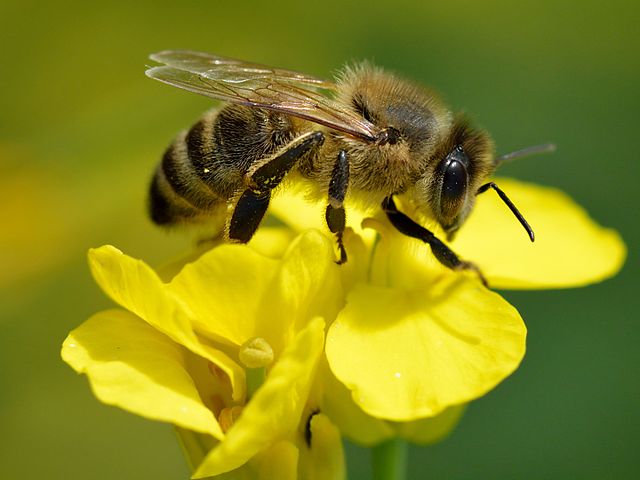
Western Honey Bees (Apis mellifera) are European honey bees and some of the most common honey bees in the world. These eusocial bees, create colonies with a single queen, non-reproductive females, and males. One colony can be home to thousands of bees.
This was one of the first domesticated insects, kept by beekeepers for their honey and pollination. The western honey bee can now be found throughout the world, except in Antarctica.
These are adaptable bees that can live in most environments and are spread geographically.
4. Two-spotted Bumble Bee

Two-spotted Bumble Bees (Bombus bimaculatus) are social bees common in Minnesota. They have two yellow spots on their abdomens. They are excellent pollinators, foraging in a range of different plants.
The workers are similar to queens, with the only difference being size. Queens have black faces with a yellow triangular patch on the vertex and a yellow thorax. Males have black faces with yellow hair.
Workers are the smallest, which can grow to 3.6mm with queens being 4.1mm. They create underground nests, usually in gardens and wooded areas.
5. Tricolored Bumble Bee

The Tricolored Bumble Bee (Bombus ternarius) is also known as the orange-belted bumblebee and is yellow, orange, and black in color. They build nets underground and create colonies.
These bumblebees are important pollinators for milkweeds and goldenrods. They are slender. With queens growing to 19mm, workers growing to 13mm, and drones to around 13mm.
Queens and the workers both have black heads with some yellow hairs. The first and fourth segment of the abdomen is yellow and the second and third are orange. The posterior is black.
Drones have yellow heads with some black hairs. The thorax and abdomen are similar to the females except their last abdominal segment have yellow on the sides.
6. Black-and-gold Bumble Bee
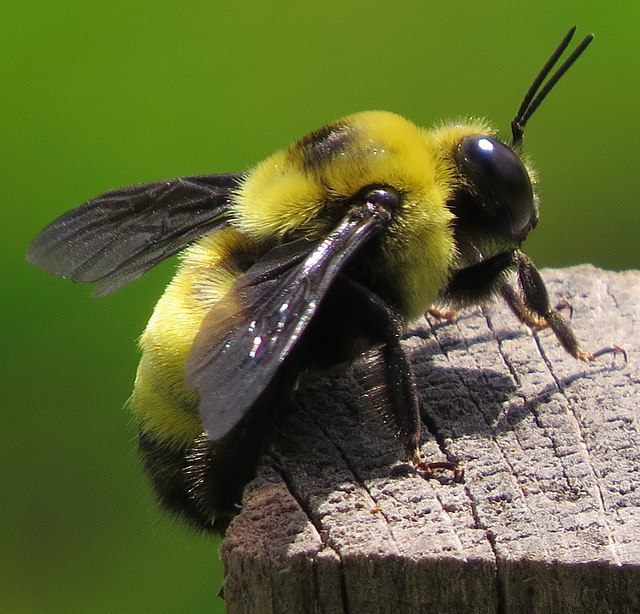
The Black-and-gold Bumble Bee (Bombus auricomus) is a common bee found in Minnesota. They create nests above the ground in open habitats, feeding on plants. This is a large bumblebee species.
These bees are large bodies with short hair. They have a black thorax with some yellow hairs. The first abdominal segment is black with the second and third being yellow.
7. Red-belted Bumble Bee

Red-belted Bumble Bees (Bombus rufocinctus) can grow to 1.8cm in length for queens with an abdomen that is around 1cm wide. They have black heads with gray and yellow hair. There is bright yellow and some red hairs on their abdomen.
Workers can grow to 1.2cm in body length, while males grow to 1.3cm. They are mostly black with yellow on their head and abdomens. They are usually encountered in wooded areas, urban parks, and gardens feeding on a range of plants. They nest on the ground or just above ground level.
Their abdomens are black, yellow, and red. Males are similar in color with yellow beards on their faces.
8. Rusty-patched Bumble Bee

This (Bombus affinis) is a relatively large bumblebee you may encounter in Minnesota. They build underground nests, often found in old rodent burrows. Nests can house up to 2,100 members in captivity. They are excellent pollinators of a range of plants.
Queens can grow to 22mm in length, workers grow to around 16mm in body length. Both have black hair covering their heads and legs, along with the bottom of the abdomen. Yellow hair can be seen on the abdomen, except closest to the rear end.
The males grow to around 17.5mm with some white hairs on the top of their heads and black streaks over their yellow abdomens.
9. Half-black Bumble Bee

The Half-black Bumble Bee (Bombus vagans) is a small bumblebee with a medium-length tongue. They have a yellow head thorax and the first two segments of the abdomen, while the rest of the body is black. Their face is a mix of black and yellow, while the thorax is covered in yellow hair.
These bees tend to forage in shady forested areas with drones being seen on goldenrod or aster later in the season. Nests can be found on the ground surface and in holes with each colony having approximately seventy workers.
10. Lemon Cuckoo-Bumble Bee

Lemon Cuckoo-Bumble Bee (Bombus citrinus) is a lemon color, often seen in Minnesota. They invade the colonies of other bumblebees killing the queen and taking control of the workers. They are known to invade half-black bumblebee nests.
The queen forages on various plants before she invades another species nest.
11. Bicolored Striped Sweat Bee

The Bicolored Striped Sweat Bee (Agapostemon virescens) is a small bee that will sting if disturbed. They have a shiny head and thorax in metallic green. Their abdomens are black and yellow. These bees are attracted to human perspiration.
They nest in the ground in colonies, often damaging lawns. Adults are seen gathering pollen and will retreat into their nest if someone passes. They are beneficial pollinators.
12. Golden Northern Bumble Bee

The Golden Northern Bumble Bee (Bombus fervidus), also known as the yellow bumblebee is common in Minnesota with its yellow abdomen and thorax. You encounter this bee in farmlands and cities
This bumblebee is a beneficial pollinator that is slowly declining in North America. They grow to around 16mm in length. Their abdomens are yellow with a black face. There is a black band between the base of their dark gray wings.
They are often encountered in tall grass, grasslands, and savannas and will co-exist in agricultural and suburban areas.
13. Two-spotted Longhorn Bee

The Two-spotted Longhorn Bees (Melissodes bimaculatus) have exceptionally long antennae. They have two light spots at the end of the abdomen, which are visible against their black bodies. Long yellow hairs cover their hind legs, often looking like pollen dust.
They are often encountered in spring and early summer collecting pollen from blooming flowers, with a preference for agricultural fields.
14. Broad-handed Leafcutter

Broad-handed Leafcutters (Megachile latimanus) are often encountered from May to October where they feed on a range of different flowers. These bees collect leaf cuttings, which they use to line their nests. They are solitary bees with males having very thick and hairy legs.
15. Perplexing Bumble Bee

The Perplexing Bumble Bee (Bombus perplexus) or confusing bumblebee is native to North America and often observed in Minnesota.
Queens can grow to 2.1cm in length and almost 1cm in width. They are mostly black with some pale hair. Workers grow to 1.4cm and have more yellow hair than the queens. Workers also have black and yellow abdomens.
Males are also 1.4cm in length with red-tipped mandibles and white hairs on their legs and head. Their thorax is covered in white and yellow hairs. They are common in wetland habitats, urban gardens, and wooded areas, feeding on a variety of plants.
16. Ligated Furrow Bee

The Ligated Furrow Bee (Halictus ligatus) can grow to 10mm in females and 9mm in males. They have well-defined banding. The males have light-colored antennae, while females have larger heads.
These bees can be encountered throughout the year, where they are excellent pollinators, visiting a variety of flower families.
17. Northern Amber Bumble Bee

The Northern Amber Bumble Bee (Bombus borealis) is native to North America and common in Minnesota, where queens can grow to 2.2cm in length. These bumblebees have yellow hairs on their body and white hairs on their heads.
Workers and males are similar in color with females growing to 1.3cm and males to 1.7cm. They are often found in woodland habitats, where they nest underground. They feed on a range of wild plants from goldenrods to thistles and blackberries.
18. Yellow-banded Bumble Bee

The Yellow-banded Bumble Bee (Bombus terricola) has unusual behavioral traits, they have the unique ability to adapt to a nest without a queen. They are also able to regulate their body temperature, enabling them to fly in cold weather and decide on which flowers to visit.
They are excellent wildflower pollinators. They are black and yellow with a fridge of yellow to brown hair on their fifth abdominal segment. Queens grow to 18mm in length with a yellow/brown front half of their thorax, along with the second, third, and fourth segment and the sides of the sixth segments of their abdomens. The rest of their body is black.
Workers are similar in appearance to the queen, but smaller, growing to 14mm, while males grow to 17mm with yellow/brown second, third and seventh abdominal segments. They occupy a full range of habitats including urban habitats. They can also be found in wetlands, woodlands, grasslands, and farmlands.
19. Dunning’s Miner
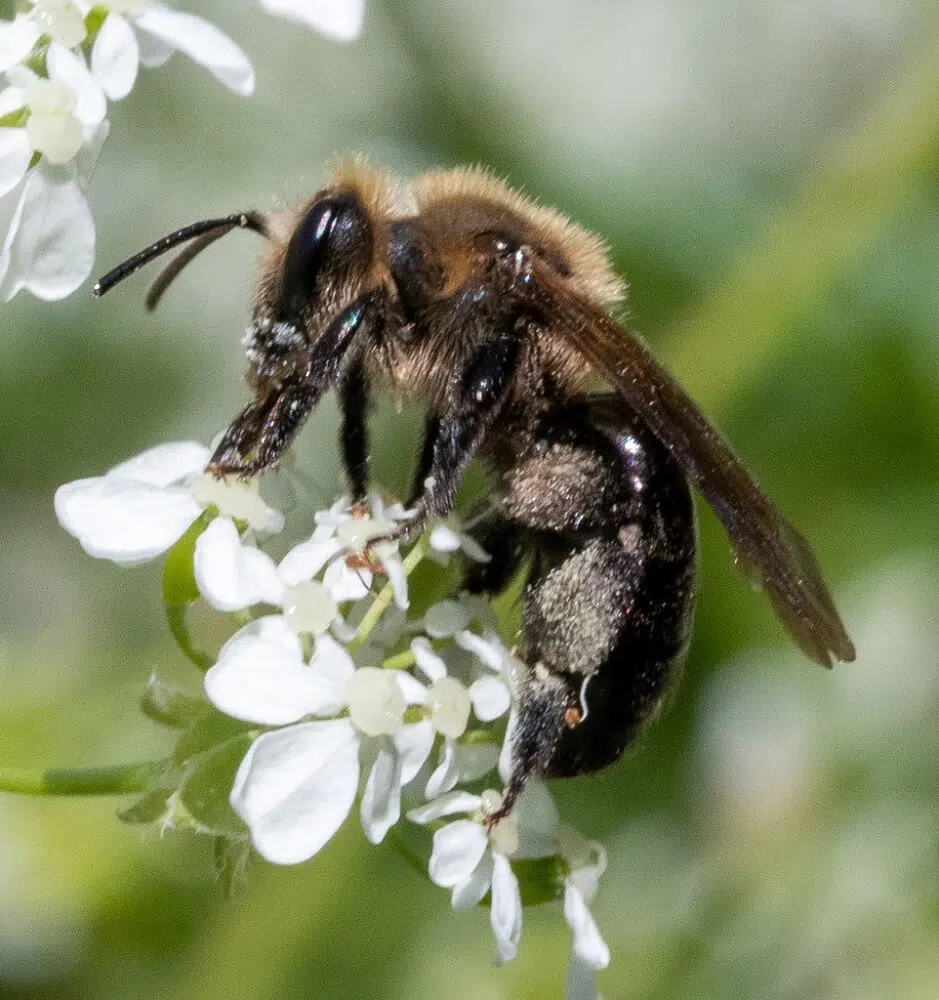
The Dunning’s Miner (Andrena dunningi) has orange thoracic hairs and is usually found in or near woodland areas. They are more common from April to June where they visit a range of flower species, being beneficial to wildflower pollination.
20. Unequal Cellophane Bee
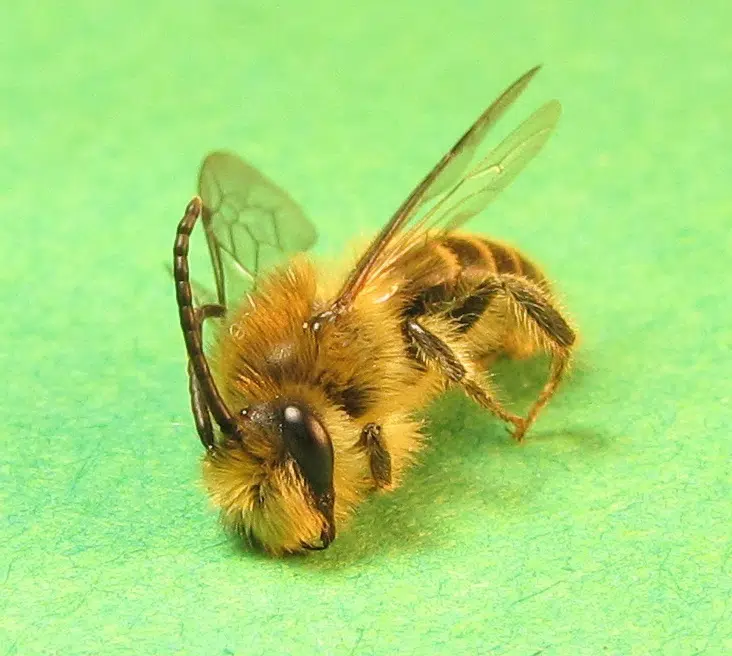
The Unequal Cellophane Bee (Colletes inaequalis) can grow to 13mm in females and 10mm in males. They have been introduced around the world and are no strangers to a number of flower species in Minnesota.
They are more common from March to July, which some being observed in August and September.
21. Pure Green-Sweat Bee

The Pure Green-Sweat Bee (Augochlora pura) is a solitary bee that is known for being bright green. They forage in a wide variety of plants.
They live in rotting logs with males and females finding human perspiration appealing. They grow to around 8mm in length with a green, shiny body. They are more active from February to November, building nests in forests where there is rotting wood. They are known to inhabit woodpiles
They don’t wander far from their nests, vising nearby pastures, and brushes.
22. Orange-legged Furrow Bee

Orange-legged Furrow Bees (Halictus rubicundus) are sweat bees with different social behaviors depending on the climate they are in. They are solitary at high elevations where there is a shorter season, but they are eusocial in other areas.
Females can grow to 1cm in body length and are brown with white bands on their abdominal segments with rusty orange-colored legs. Males are slender with long antennae and yellow on their faces and legs.
23. Confusing Furrow Bee

The Confusing Furrow Bee (Halictus confusus) can grow to 7mm in length with females having a green head and thorax with black on the abdomen with metallic highlights. Males are similar but have red veins on their wings and yellow stories on their tibia and tarsi.
24. Milwaukee Mining Bee
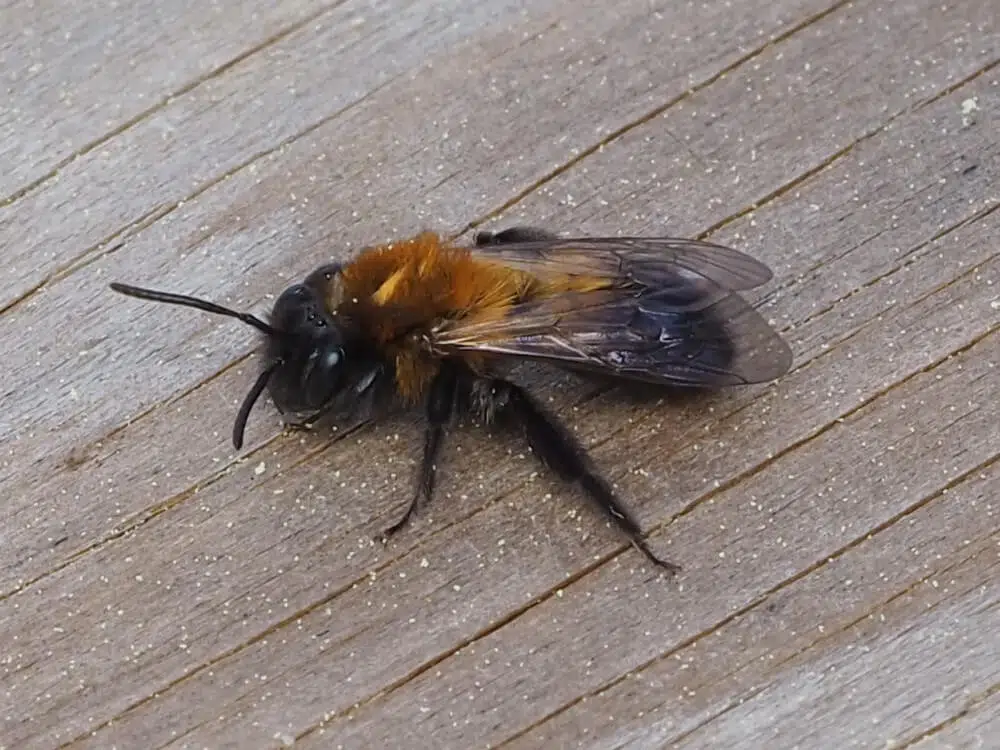
The Milwaukee Mining Bee (Andrena milwaukeensis) has orange hairs on the first and second segments in both males and females. They are not large bees, which are usually encountered in woodlands from March to August.
25. Metallic Epauletted-Sweat Bee

The Metallic Epauletted-Sweat Bee (Augochloropsis metallica) is a green bee that has a bean shape. They grow to around 9mm in length and have a desire to lick human perspiration. These bees are common from March to November as they visit flowers from a range of different families.
26. American Bumble Bee

The American Bumble Bee (Bombus pensylvanicus) is a threatened species, with numbers declining significantly. The population of American bumblebees has dropped by almost ninety percent in the past twenty years.
They prefer open farmlands and fields, where they favor sunflowers and clovers. Their thoracic dorsum is yellow with a black posterior and alternating black and white tergal segments with short hairs.
Queens can grow to 26mm, while workers grow to 19mm. They forage close to their nest, only traveling around 1.5 miles.
27. Wilke’s Mining Bee

The Wilke’s Mining Bee (Andrena wilkella) is a miner bee that is originally from Europe. It was accidentally introduced to North America and is mostly active from April to August. They can nest on their own or in aggregations.
Females grow to 12mm and males to 11mm in length. They prefer clover and sweet clover and are active pollinators. Males often fly in large numbers.
28. Eastern Thistle Longhorn
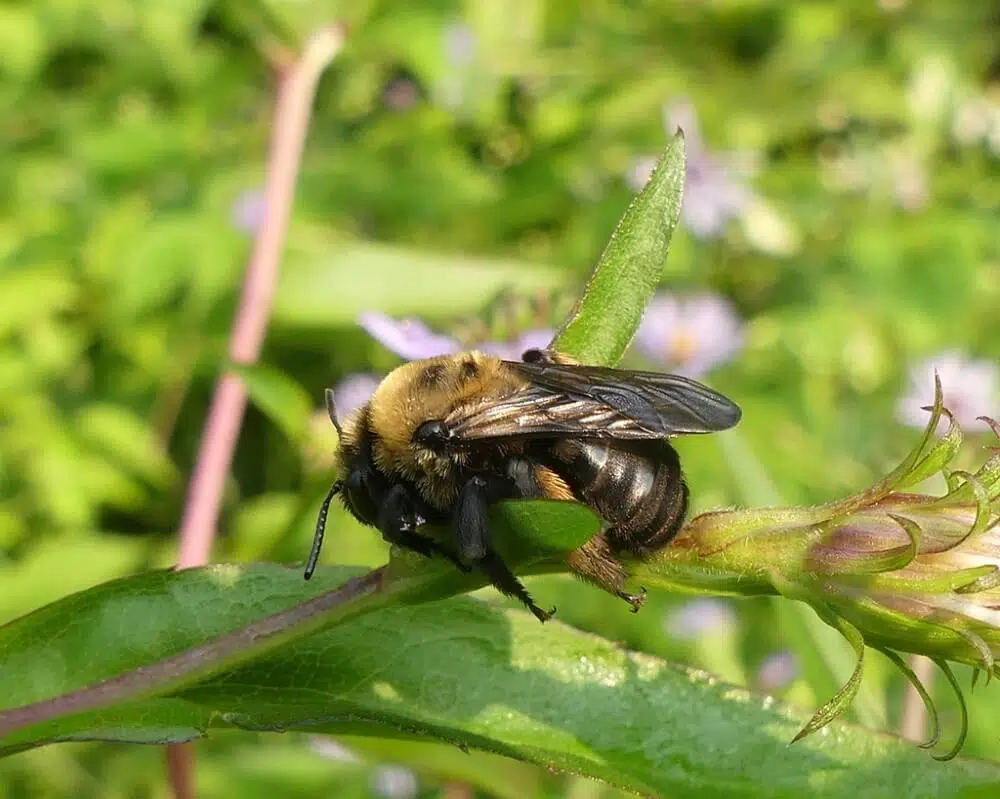
The Eastern Thistle Longhorn Bee (Melissodes desponsus) has long antennae and is an essential pollinator for the crop industry. They are medium in size and robust with hairy bodies, heads, and back legs. The male’s antennae are longer than the female.
Males and females both have blue/gray to green eyes. They are mostly encountered from July and August where they carve holes in the earth to construct individual nests.
29. Dark-veined Longhorn Bee
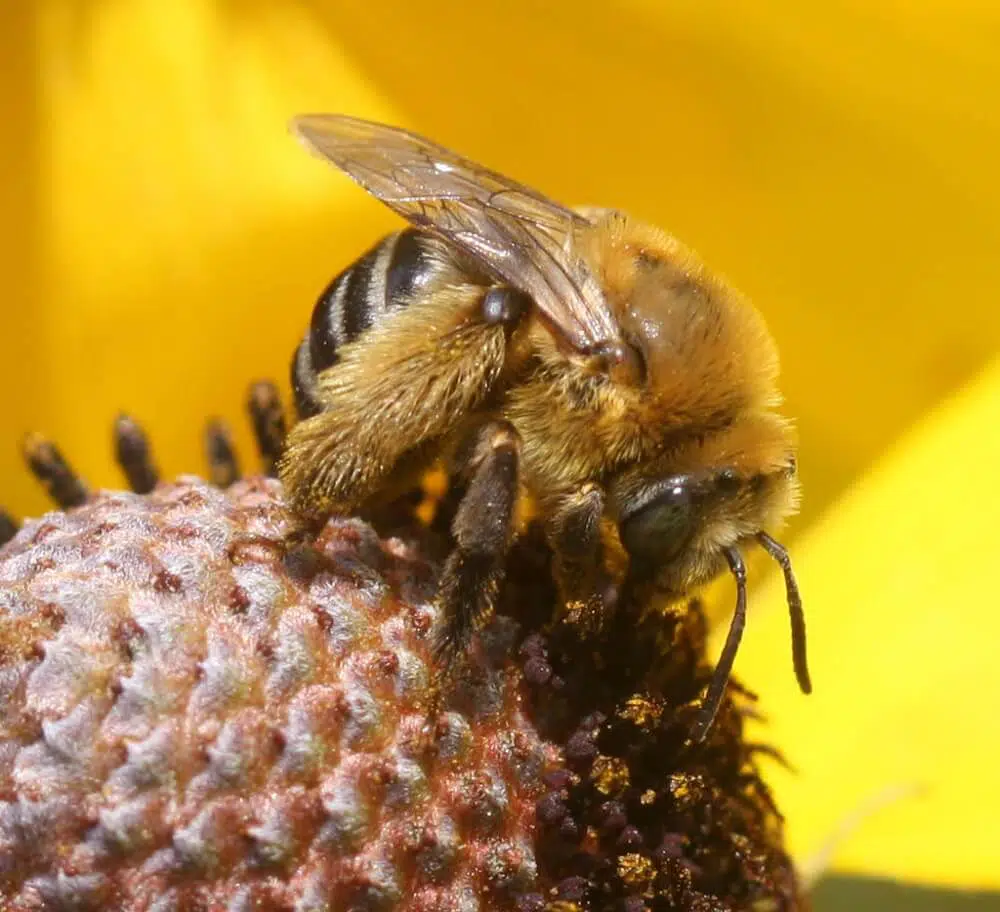
The Dark-veined Longhorn Bee (Melissodes trinodis) has wing veins that are dark with a pale spot at the base of their mandibles. They have orange thoracic hairs, with the hairs being more noticeable at the top of their heads.
Females can grow to 12mm in length and males to 11mm. They are more common from July to October, where they visit a number of different flower species, being beneficial pollinators.
30. Neighborly Mining Bee
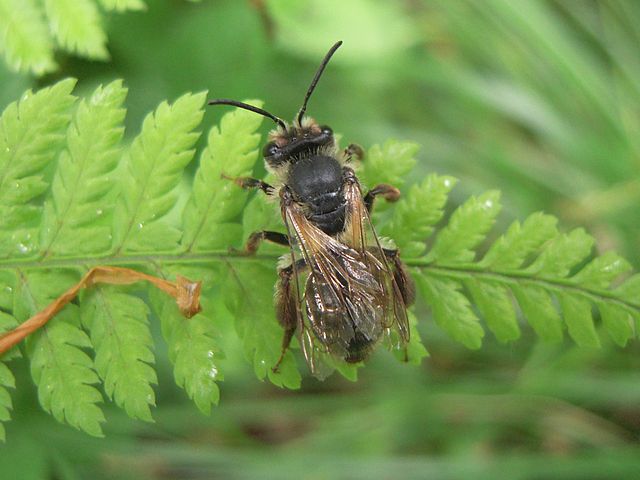
The Neighborly Mining Bee (Andrena vicina) is a North American miner bee, which is large in size with pale thoracic hairs. They are more common in orchards and woodlands in the springtime. These bees pollinate blueberries and Viburnum.
They flourish in temperate areas and are almost immune to cold weather. They need to increase their body temperature in order to fly, so it’s not uncommon seeing them on rocks and leaf litter sunning themselves.
The name “mining bee” is due to their behavior in constructing underground nests. The hole in the ground is about half an inch in width and covered in leaf litter. Each female is responsible for building and provisioning her own nest.
These are essential pollinators in a range of native wildflowers, along with garden plants. They are not aggressive with fragile stingers, which are unable to sting humans. They rather fly away rapidly to escape.
31. Modest Masked Bee

The Modest Masked Bee (Hylaeus modestus) is also known as the yellow-faced bee, is often encountered in Minnestoa as they visit flowers from a range of different families.
Males and females both grow to around 7mm and have a yellow masks on their faces, which are smooth and hairless. They are more common from May to September.
32. Megachile inermis
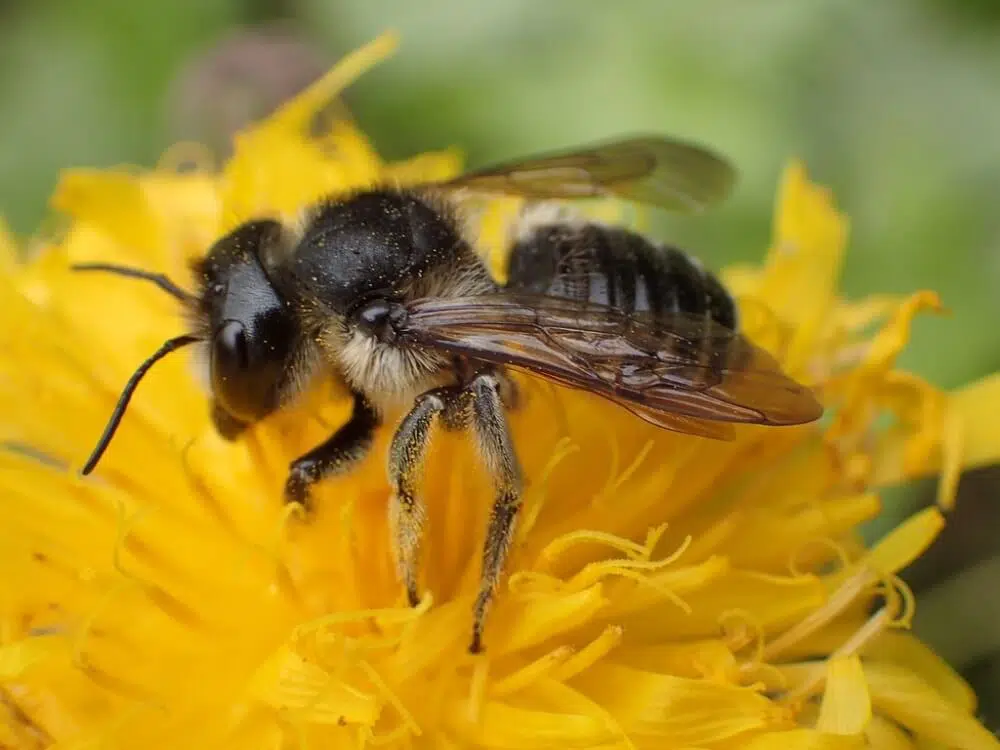
This bee was first described in 1888, though there is little information about it. These bees are almost wasp-shaped with a pointed abdomen in black and gray with a black head, thorax, and legs.
They have yellow hairs on their abdomen, which can be mistaken for pollen dust. The wings are transparent gray with visible darker gray veins.
33. European Woolcarder Bee
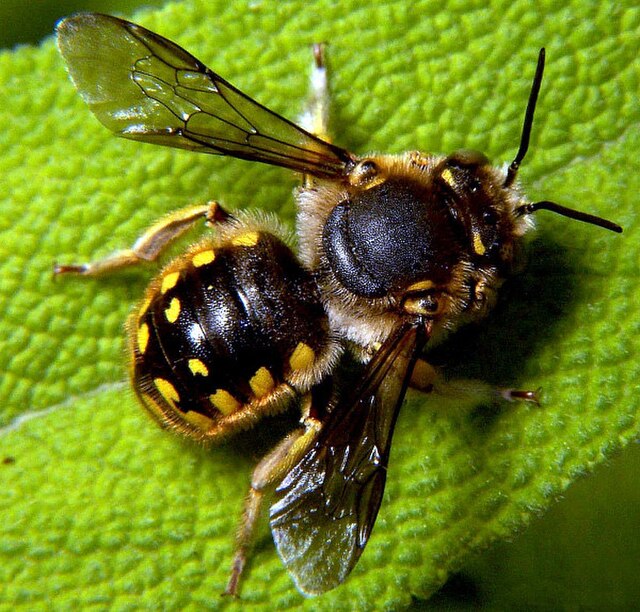
The European Woolcarder Bee (Anthidium manicatum) is a leaf cutter or mason bee. Their name is derived from the way they scrape the hair from leaves. They bundle the leaf hair under their body and use it for nest lining. Unlike other leafcutters, they do not cut the leaves.
The males are very territorial and will chase other males and bees from their pollinating territory. They originate in Europe and were accidentally introduced to North America, where they have become invasive pests.
These bees can grow to 20mm in length for queens, females grow to 13mm, and males to 17mm in length. Males are larger than females.
The European woolcarder bee is black and covered with yellow to gray colored hairs. The abdomen and face have yellow spots. Males have black heads and thorax, which are covered in short yellow/brown hairs.
The female is smaller than the male and similar in color pattern with a rounded posterior.
34. Blue Orchard Bee

The Blue Orchard Bee (Osmia lignaria) is also known as an orchard mason bee and makes nests in natural holes and reeds. They do not drill holes in wood, unlike carpenter bees. They are common in early spring and are often cultured for pollination.
35. Golden Sweat Bee

The Golden Sweat Bee (Augochlorella aurata) is a small bee that is a golden-green color, though it can range from copper pink to metallic blue. Males and females grow to around 7mm with females being ever so slightly bigger than the males.
They are more common from May to November, where they can be seen flying from flower to flower.
36. Oblong Woolcarder Bee

The Oblong Woolcarder Bee (Anthidium oblongatum) belongs to the leafcutter or mason bee family that is common in warm and dry locations, including hedges, grasslands, road embankments, and settlement areas. Their nests are close to their pollen sources.
37. Orange-tipped Wood-Digger
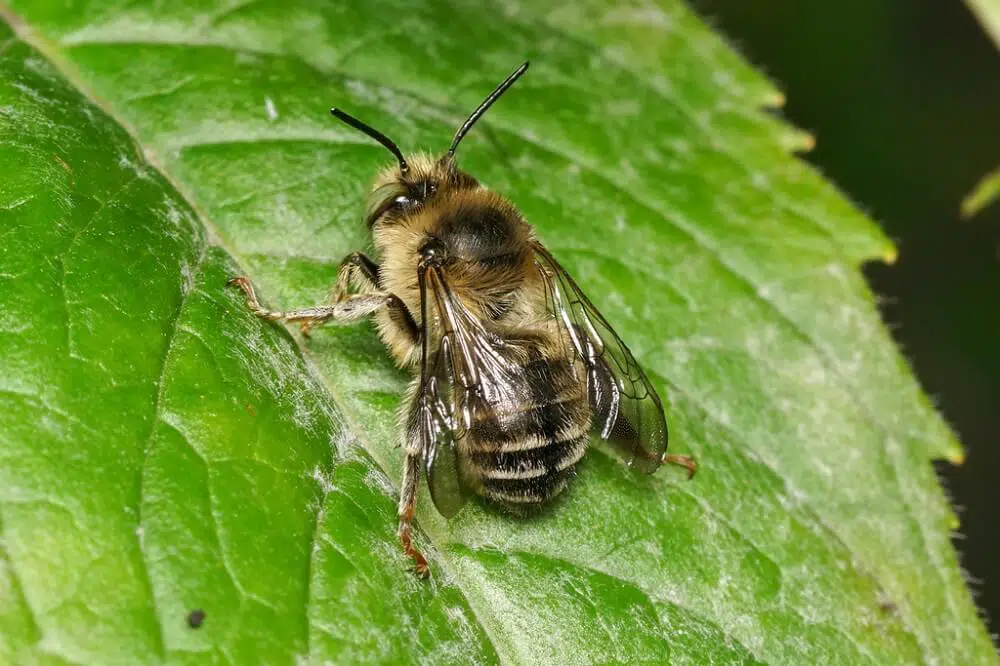
The Orange-tipped Wood-Digger (Anthophora terminalis) has an orange tip on the abdomen, with thin hair banding on their black abdomens. This furry bee is distinctive, often found around woodlands, hovering above flowers and sometimes resting on leaves.
Their diet preference is long tubed flowers. Females have a distinct orange tip on their abdomens, while males have yellow on the lower part of their face. Both are gray/brown with banding on the abdomen.
Further Reading: